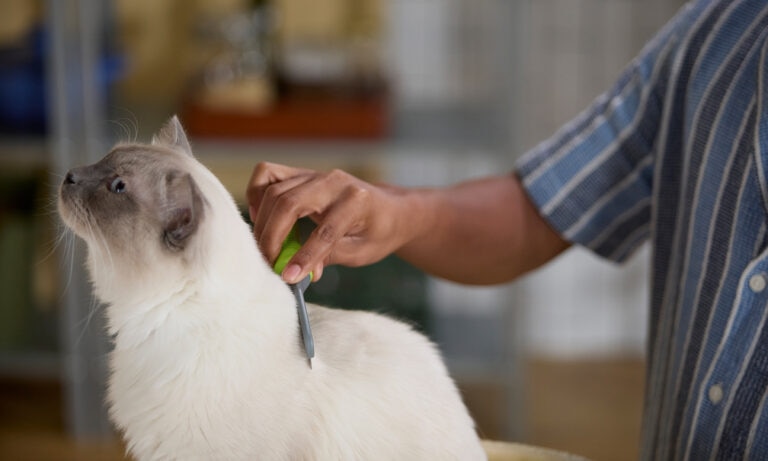When Is Flea Season?

Photo by Irina Orlova/iStock/Getty Images Plus
Fleas—those tiny, agile parasites—not only cause discomfort and irritation to pets, but they can also lead to more serious health issues, such as anemia, tapeworms and skin infections, if left unchecked.
Fleas thrive in warm, humid climates and typically die off or lie dormant in cold temperatures. As such, the warmer months are typically considered “flea season.” But here’s the twist: In many areas where winters are more “light jacket” weather than “heavy coat” season, these little critters can keep the party going outdoors all year long.
What’s more, fleas are experts at hiding indoors when the outside temperature drops. That means your pets are always at risk for a flea infestation, no matter the time of year. So, if you’re wondering if fleas are active in winter, the answer, unfortunately, is “yes, they can be.”
We spoke to vet experts to get the specifics of flea season in each state and learn effective treatment and prevention options to keep your pets and home flea-free.
When Is Flea Season in Your State?
Flea season can differ from one state to another due to the diverse climates across the United States. However, it’s best to keep your pet on a year-round flea preventative, as recommended by your veterinarian. This is because fleas can survive a harsh winter by hiding in areas protected from the cold, such as your home, barn, garage or crawl space.
Still, it’s helpful to know when fleas are most prevalent in your area. Find out when flea season is in your state, according to Dr. Sara Ochoa, DVM, a veterinarian at Animal Hospital of West Monroe in West Monroe, Louisiana, and the co-founder of How to Pets; and Dr. Jamie Whittenburg, DVM, owner and director of Kingsgate Animal Hospital in Lubbock, Texas.
| Flea Season (Months) | States Affected |
|---|---|
| January-December (year-round) | Alabama, Arizona, California, Florida, Georgia, Hawaii, Louisiana, Mississippi, Nevada, North Carolina, Oregon, South Carolina, Texas, Washington |
| February-December | Arkansas |
| March-December | Delaware, Idaho, Illinois, Indiana, Kansas, Kentucky, Maryland, Missouri, New Mexico, Ohio, Oklahoma, Pennsylvania, Tennessee, Utah, Virginia, West Virginia |
| April-December | Connecticut, Massachusetts, Michigan, New Jersey, New York, Rhode Island |
| April-November | Colorado, Iowa, Maine, Minnesota, Montana, Nebraska, New Hampshire, South Dakota, Vermont, Wisconsin |
| May-November | North Dakota, Wyoming |
| May-October | Alaska |
My Pet Has Fleas—What Do I Do?
If you discover your pet has fleas, it’s important to act swiftly and effectively to alleviate their discomfort and prevent further infestation. Here’s what to do, according to veterinarians.
1. Confirm the Flea Infestation
First, make sure it’s fleas you’re dealing with, says Dr. Ochoa.
Fleas are tiny (1.5-5 mm, about the size of the tip of a pen), fast and appear brown or black. Here’s what fleas—and flea dirt (aka flea poop)—look like. Then, look for these signs of fleas in dogs and in cats.
2. Begin Flea Treatment ASAP
Once you’ve confirmed your pet has fleas, don’t delay starting treatment. Flea treatments include shampoos, sprays, oral medications and topical medications. Consult with your veterinarian on the best treatment for your pet. Then, watch our Chewtorials on how to get rid of fleas on dogs and cats (for good!).
3. Treat All Your Pets
It’s crucial to treat all the pets in your household—not just the one you’ve confirmed has fleas, says Dr. Ochoa. “Fleas can jump from host to host, so make sure everyone gets treated to prevent an infestation merry-go-round,” she adds.
4. Clean Your Home Thoroughly
Fleas don’t just stay on your pet—they can get in the nooks and crannies of your home, too. After treating your pets, do the following:
- Wash all pet and human bedding and linens in hot water.
- Vacuum all carpeting, floors and upholstery.
- Dispose of the vacuum bag or clean the canister outside.
Here’s our complete guide on how to get rid of fleas in your home.
5. Continue Treating Your Pet and Home
Continue treating your home and yard every 3-4 weeks, for the next 3-6 months. This might sound excessive, but it’s necessary due to the lifecycle of fleas, says Dr. Whittenburg. For example, did you know a single adult female flea can lay up to 50 eggs per day? And adult fleas can live up to 100 days? Learn all about the lifecycle of fleas.
You should also:
- Make it a habit to check your pet’s coat for fleas every couple of weeks.
- Consult with your veterinarian about the frequency of baths using flea shampoo.
- Give your pets a flea preventative on a strict schedule, as suggested on the product instructions or by your veterinarian.
How To Protect Your Dog Against Fleas

Wirestock/iStock/Getty Images Plus
As the saying goes, “an ounce of prevention is worth a pound of cure.” Don’t wait for fleas to show up to start prevention measures. Being ahead of the game will make your life, and your dog’s, much more comfortable.
So, how can you reduce the risk of a flea infestation in the first place? Here are our top tips.
- Give your dog regular flea treatments. Treatments include topical treatments, oral treatments, flea collars and flea sprays and wipes. Consult with your vet to determine the best method for your pet, and stick to a strict schedule. Learn more about the different types of flea treatments for dogs.
- Keep your environment clean: This includes vacuuming your carpets, floors and furniture frequently and washing your dog’s bedding weekly.
- Bathe and brush your dog regularly: Give your dog a good bath every 4-6 weeks to help wash away fleas and their eggs. And aim to brush your dog every couple of days, during which you can look for fleas.
- Maintain your yard: Fleas thrive in shady, moist environments and tall grass/foliage. To limit these environments, keep your grass cut short and your bushes trimmed.
- Have regular checkups with your vet: This will help catch flea problems early before they become full-blown infestations.
Remember, prevention is key!
How To Protect Your Cat Against Fleas

bombermoon/iStock/Getty Images Plus
Cats are equally, if not more, prone to fleas. If you have a cat who lives both indoors and outdoors, the risk of a flea infestation on your cat and in your home is even greater. And if your cats live exclusively outside, they’re even more susceptible to fleas.
Protecting your cat against fleas involves the same strategies as protecting a dog, but with a couple of crucial differences:
- Make sure you use flea prevention products safe for cats: Products designed for dogs can be harmful or even fatal to cats due to different sensitivities and dosages. For example, dog flea preventatives contain permethrin, which is highly toxic to cats, says Dr. Whittenburg. Your vet will recommend the best product for your cat.
- You may not need to regularly bath your cat: Cats spend a lot of time grooming themselves to cover themselves in their scent; so, regular baths are not usually necessary or recommended for cats as a flea preventative. When you bathe them, you essentially diminish their ID. Exceptions to the less-bathing rule include:
- Hairless cat breeds who have oily skin
- Cats who have been skunked, soiled themself or rolled in some source of nastiness
- Cats unable to groom themselves properly due to age or illness
- Cats who have a flea infestation (in this case, a bath with a cat-safe flea shampoo can be part of the treatment)












